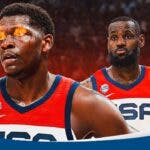LaMelo Ball may have edged out Anthony Edwards for the Rookie of the Year award, but there's no denying those two were the top rookies of their class for the 2020-21 season. Though the class of 2021 looked loaded with promising young talent across the board, it's clear that Ball and Edwards were ahead of their peers.
Despite going scoreless in his debut NBA game, the Charlotte Hornets stud dazzled throughout his rookie campaign. He clearly looked like the runaway favorite for top rookie honors through the first few months of the season. However, a midseason wrist fracture that kept him out for 21 games threatened his case for a while there, especially since Edwards went on an absolute tear through the second half of the season after initially struggling out of the gates. The Minnesota Timberwolves rookie looked like a completely different beast after the All-Star break.
The Hornets and Timberwolves clearly found gems with Ball and Edwards, respectively. There's no doubt that both will have a bright future and should become perennial NBA All-Stars. With that said, which of these two studs is the better player to build a franchise around?
Before answering that, let's begin by comparing their production. Anthony Edwards suited up for all 72 games, starting in 55 of them. He ended up with season-long averages of 19.3 points, 4.7 rebounds, and 2.9 assists, while shooting just 41.7 percent from the field. As mentioned, it took a while for Edwards to find his footing in the NBA. Edwards averaged 14.9 points on a paltry 37.1 percent shooting through the first 36 games of the regular season.
But after All-Star Weekend, the 6-foot-4 high-flyer seemed to have flipped a switch. Through the second half of the season, Edwards put up All-Star type numbers of 23.8 points on 45.4 percent field goal shooting and a decent 34.9 percent clip from beyond the arc. In the end, Edwards led all rookies in scoring and dropped his career-high of 42 points on two separate occasions.
Meanwhile, Ball's numbers were a bit more all around and his production was pretty much consistent throughout the year. This is perhaps why he still ended up winning Rookie of the Year, despite being sidelined for over a month and Edwards' late season tear.
In 51 appearances, including 31 starts, the 6-foot-6 point guard averaged 15.7 points, 5.9 rebounds, 6.1 assists, and 1.6 steals while shooting 43.6 percent from the field. A lot of pundits were also concerned with Ball's 3-point shooting, but he ended up making a respectable 35.2 percent from long range. Melo also finished second in scoring behind Edwards and led all rookies in assists and steals. And despite being a guard, he also finished second in rebounds.
Both Anthony Edwards and LaMelo Ball possess flashy games. Edwards gives you the highlight dunks, the athletic finishes, whereas Ball's highlight package boasts of nifty passes, creative layups, and other craftier moves.
There's no doubting Edwards' ability to be a lights out scorer and an all-around bucket-getter with the way he can score from inside and out. But Ball's more well-rounded game is perhaps his main edge over Edwards. In addition, the reigning Rookie of the Year's innate feel for the game also seems more advanced, with the way he can impact the game in several ways.
Ball's elite playmaking is arguably the greatest aspect of his game. His ability to facilitate and control the offense and create for his teammates sets him apart, not just with Edwards, but among his peers. Ball also has a knack of keeping his head up whenever he grabs the defensive rebound. His ability to grab-and-go has led to and should generate a lot of easy transition buckets for the Hornets.
Ball and Edwards both definitely made their marks and flashed their potential on the offensive end, albeit in differing fashions. But on defense, the Hornets facilitator also showed he was just a little more advance on that end of the floor.
Defense was arguably the biggest concern of both Ball and Edwards coming into the league. The two definitely have the tools, the body, and athleticism to become great defenders in the NBA.
Ball is a stringy 6-foot-6, but his length allows him to be a disruptive defender. Meanwhile, Edwards possesses a bulky 225-pound frame to go with freakish athleticism. But, as we know, a huge part of defense hinges on effort and on-court awareness. Both were questionable at best when it comes to those aspects on that end of the floor before coming to the NBA.
But as the season went along, Ball showed that cared just a little bit more on defense in the NBA compared to what he showed when he played with the Illawara Hawks in the National Basketball League in Australia. He showed great anticipation on reading and picking passing lanes and showcased good activity in staying in front of his man.
As for Edwards, we mentioned how he has the athleticism and the body to become a defensive menace in the NBA. However, he needs to be more committed in exerting consistent effort on that end of the floor. He showed a lack of awareness when defending in space and in transition and looked lost at times in making the right defensive rotations. The on/off numbers back it up as well. According to FiveThirthyEight’s RAPTOR metric, Edwards was a negative defensively for the Timberwolves whenever he hit the floor.
Based on their rookie seasons, it looks like LaMelo Ball is the better star to build around compared to Anthony Edwards. Melo's all-around impact, better feel for the game, and more advanced defense at this point puts him above Antman. Of course, the Timberwolves stud can still improve and catch up with Charlotte's prized sophomore. But as it stands, Ball is the star you pick if you want a better chance to win.




